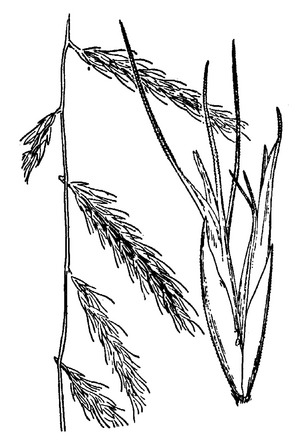Purple grama facts for kids
Quick facts for kids Purple grama |
|
|---|---|
 |
|
| Inflorescence at left, with a single floret at right | |
| Scientific classification | |
| Genus: |
Bouteloua
|
| Species: |
radicosa
|
Purple grama (also known as Bouteloua radicosa) is a type of grass. It's found naturally in the southwestern United States and northern Mexico. It belongs to a group of grasses called the grama genus.
What is Purple Grama Grass?
Purple grama is a plant that lives for many years. It can grow up to 80 cm (31 in) tall. This grass has a strong base with underground stems called rhizomes. These rhizomes help the plant spread and grow thick.
The plant produces flower clusters called inflorescences. These clusters look like panicles and can be 10–15 cm (3.9–5.9 in) long. Each cluster usually has seven to twelve branches. These branches can be 20–30 cm (7.9–11.8 in) long. On each branch, you'll find eight to eleven small groups of flowers called spikelets.
Each spikelet has two tiny flowers, which are called florets. The lower floret has a special part called a lemma with three pointy parts, or awns.
Sometimes, purple grama can mix its genes with other similar grasses, like Bouteloua repens and Bouteloua williamsii. This mixing is called hybridization. It can make purple grama look a bit different from one plant to another.
Where Does Purple Grama Grow?
You can find purple grama growing in places that are 3,500–7,000 ft (1,100–2,100 m) above sea level. It likes dry, grassy areas in deserts or rocky hillsides.
This grass is common in states like Arizona, New Mexico, and California. It has also been found in Maine, but it's not very common there. It was likely brought to Maine by accident.

